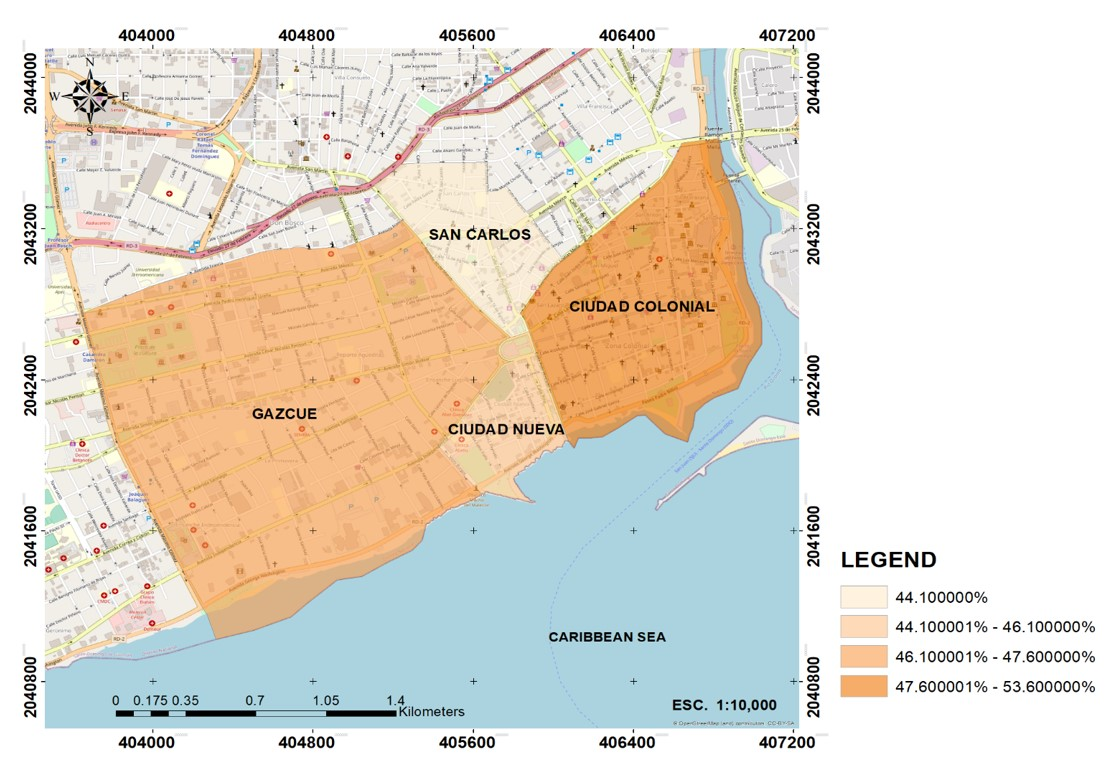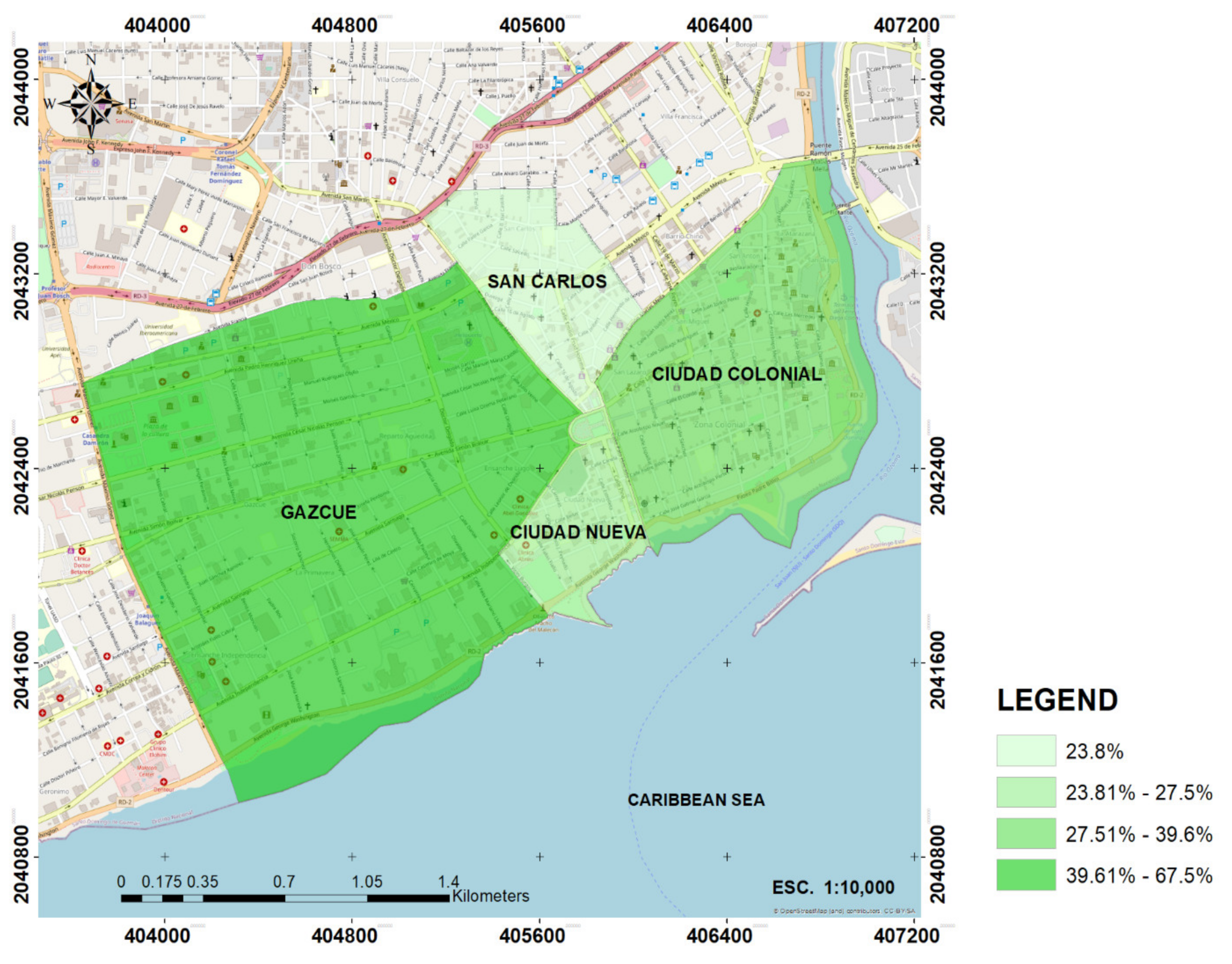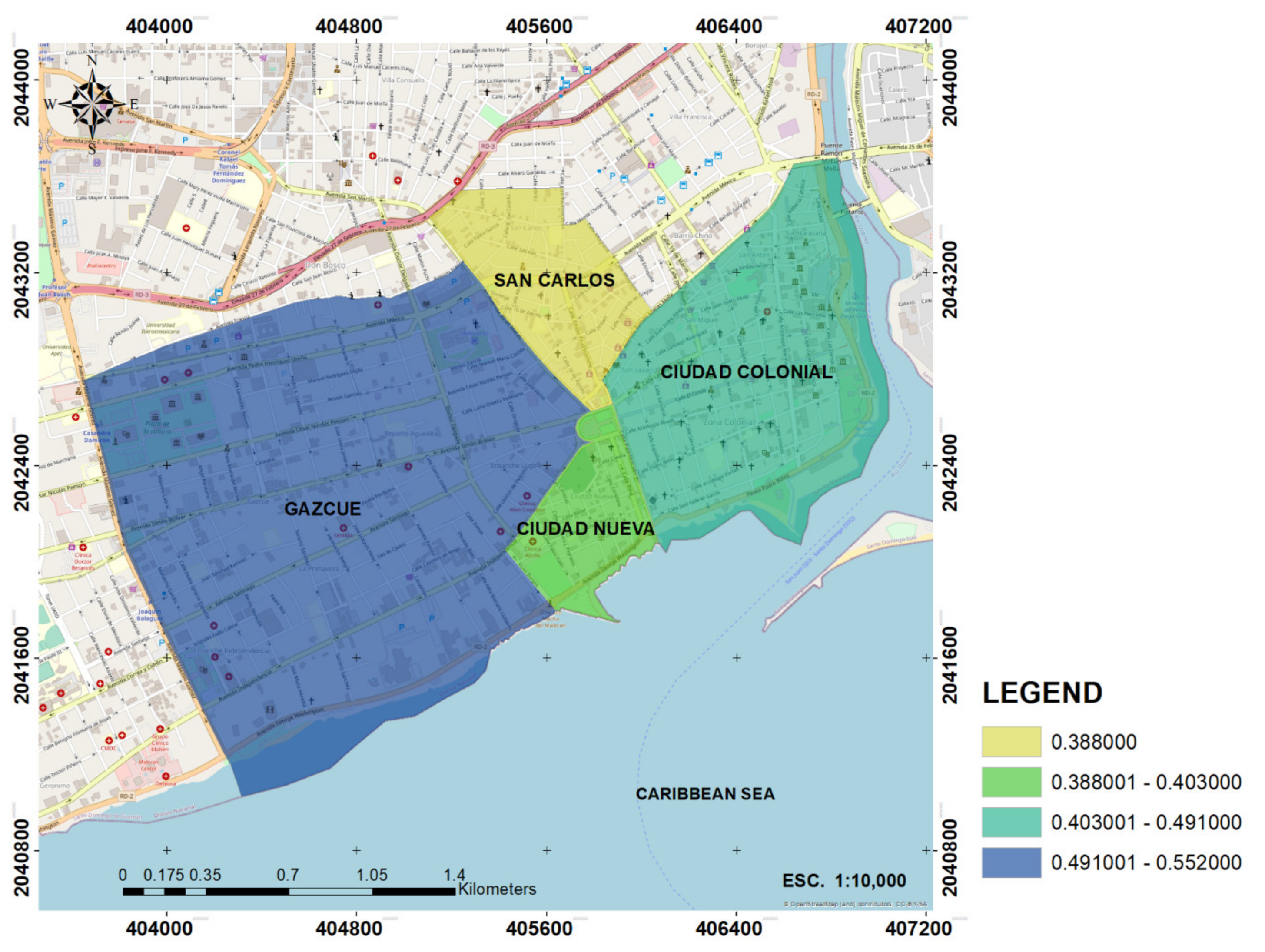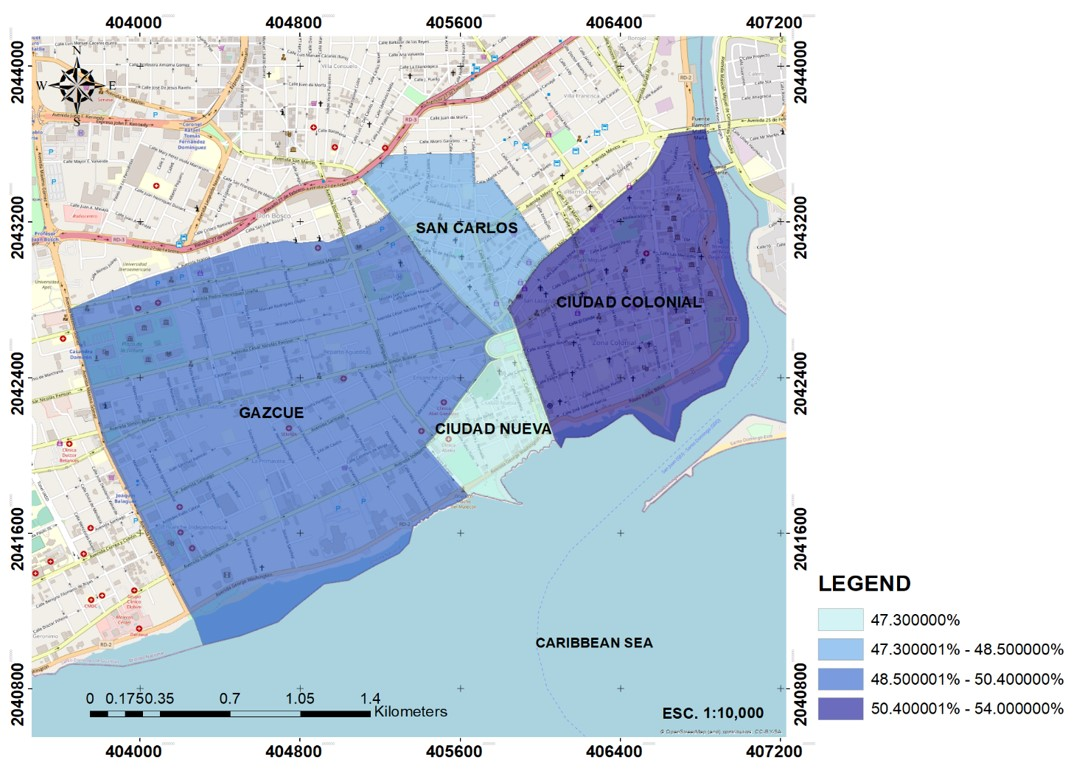Urban Forest Sustainability in Residential Areas in the City of Santo Domingo
Abstract
1. Introduction
2. Materials and Methods
2.1. Study Area General Description
2.1.1. Zona Colonial (Colonial Zone)
2.1.2. Ciudad Nueva
2.1.3. San Carlos
2.1.4. Gazcue
2.2. Methodology
2.3. Information Analysis
3. Results and Discussion
4. Conclusions
Author Contributions
Funding
Data Availability Statement
Acknowledgments
Conflicts of Interest
Appendix A
| Eigenvalues | Eigenvectors | |||||
|---|---|---|---|---|---|---|
| Lambda | Value | Proportion | Prop Accum. | Variables | e1 | e2 |
| 1 | 13.53 | 0.45 | 0.45 | Female | −0.2 | 0.19 |
| 2 | 9.52 | 0.32 | 0.77 | Male | 0.2 | −0.19 |
| 3 | 6.95 | 0.23 | 1 | Own house | 0.27 | −0.01 |
| 4 | 0 | 0 | 1 | Rent house | −0.27 | 0.04 |
| 5 | 0 | 0 | 1 | Loaned-lent house | −0.11 | −0.25 |
| 6 | 0 | 0 | 1 | Gray patio | −0.2 | −0.07 |
| 7 | 0 | 0 | 1 | Patio_plants | 0.18 | −0.11 |
| 8 | 0 | 0 | 1 | Married/common law | 0.27 | −0.05 |
| 9 | 0 | 0 | 1 | Single | −0.24 | 9.60 × 10−4 |
| 10 | 0 | 0 | 1 | Divorced | 0.1 | −0.16 |
| 11 | 0 | 0 | 1 | Widower | −0.24 | 0.16 |
| 12 | 0 | 0 | 1 | Unemployed | 0.03 | −0.24 |
| 13 | 0 | 0 | 1 | Public employee | 0.1 | 0.25 |
| 14 | 0 | 0 | 1 | Private employee | 0.13 | 0.07 |
| 15 | 0 | 0 | 1 | Businessman | −0.22 | 0.13 |
| 16 | 0 | 0 | 1 | Account worker | 0.03 | −0.15 |
| 17 | 0 | 0 | 1 | Pensioner | 0.25 | 0.12 |
| 18 | 0 | 0 | 1 | Primary studies | −0.1 | −0.28 |
| 19 | 0 | 0 | 1 | Secondary studies | 0.03 | −0.3 |
| 20 | 0 | 0 | 1 | Graduate | 0.2 | 0.19 |
| 21 | 0 | 0 | 1 | Master’s degree | 0.07 | 0.31 |
| 22 | 0 | 0 | 1 | Doctorate | −0.09 | 0.3 |
| 23 | 0 | 0 | 1 | Technical training-pro. | −0.18 | 0.24 |
| 24 | 0 | 0 | 1 | Income 0–15,000 | −0.19 | −0.15 |
| 25 | 0 | 0 | 1 | Income 16,000–30,000 | −0.23 | −0.13 |
| 26 | 0 | 0 | 1 | Income 31,000–45,000 | −0.21 | 0.18 |
| 27 | 0 | 0 | 1 | Income 46,000–60,000 | 0.16 | 0.05 |
| 28 | 0 | 0 | 1 | Income 61,000–75,000 | 0.16 | 0.27 |
| 29 | 0 | 0 | 1 | Income 76,000–90,000 | 0.08 | 0.01 |
| 30 | 0 | 0 | 1 | Income 91,000 or more | 0.25 | |
| Eigenvalues | Eigenvectors | |||||
|---|---|---|---|---|---|---|
| Lambda | Value | Proportion | Prop Accum. | Variables | e1 | e2 |
| 1 | 6.89 | 0.69 | 0.69 | Green index | 0.37 | −0.01 |
| 2 | 2.46 | 0.25 | 0.93 | Number of trees | 0.37 | 0.18 |
| 3 | 0.66 | 0.07 | 1 | Forest cover | 0.27 | −0.25 |
| 4 | 0 | 0 | 1 | Percentage of trees | 0.06 | 0.61 |
| 5 | 0 | 0 | 1 | Contamination removal | 0.37 | 0.14 |
| 6 | 0 | 0 | 1 | Carbon store | 0.36 | 0.14 |
| 7 | 0 | 0 | 1 | Oxygen production | −0.34 | 0.26 |
| 8 | 0 | 0 | 1 | Carbon sequestration | 0.06 | 0.6 |
| 9 | 0 | 0 | 1 | Runoff avoided | 0.38 | 0.01 |
| 10 | 0 | 0 | 1 | Carbon emission | 0.34 | −0.25 |
| Eigenvalues | Eigenvectors | |||||
|---|---|---|---|---|---|---|
| Lambda | Value | Proportion | Prop Accum. | Variables | e1 | e2 |
| 1 | 21.34 | 0.48 | 0.48 | like tree property | −0.1 | 0.09 |
| 2 | 13.09 | 0.3 | 0.78 | don’t like tree property | 0.1 | −0.09 |
| 3 | 9.57 | 0.22 | 1 | plant the yard | −0.07 | 0.15 |
| 4 | 0 | 0 | 1 | don’t plant | 0.07 | −0.15 |
| 5 | 0 | 0 | 1 | know which entity cares | 0.12 | −0.22 |
| 6 | 0 | 0 | 1 | don’t know which entity cares | −0.12 | 0.22 |
| 7 | 0 | 0 | 1 | fertilize the yard | 0.17 | 0.1 |
| 8 | 0 | 0 | 1 | don’t fertilize the yard | −0.17 | −0.1 |
| 9 | 0 | 0 | 1 | hire gardening | −0.14 | 0.21 |
| 10 | 0 | 0 | 1 | don’t hire gardening | 0.14 | −0.21 |
| 11 | 0 | 0 | 1 | water the yard several times | −0.19 | 0.08 |
| 12 | 0 | 0 | 1 | water the yard once | 0.18 | −0.15 |
| 13 | 0 | 0 | 1 | water the yard occasionally | 0.18 | −0.03 |
| 14 | 0 | 0 | 1 | area maintenance | −0.12 | −0.09 |
| 15 | 0 | 0 | 1 | monthly maintenance expense | −0.07 | 0.25 |
| 16 | 0 | 0 | 1 | spend on fertilizer | 0.09 | 0.22 |
| 17 | 0 | 0 | 1 | spend on pesticide | 0.06 | −0.04 |
| 18 | 0 | 0 | 1 | spend on irrigation | −0.18 | −0.14 |
| 19 | 0 | 0 | 1 | gardening labor | 0.1 | 0.01 |
| 20 | 0 | 0 | 1 | willingness to pay for maint. | 0.21 | 0.07 |
| 21 | 0 | 0 | 1 | no WTP for maint. | −0.21 | −0.07 |
| 22 | 0 | 0 | 1 | willingness to pay | 0.07 | 0.24 |
| 23 | 0 | 0 | 1 | perceive tree benefit owner | 0.14 | 0.12 |
| 24 | 0 | 0 | 1 | perceive tree issue | −0.14 | −0.12 |
| 25 | 0 | 0 | 1 | perceive tree benefit neighbor | 0.21 | −0.02 |
| 26 | 0 | 0 | 1 | don’t perceive benefit | −0.21 | 0.02 |
| 27 | 0 | 0 | 1 | connection with construction | −0.21 | −0.02 |
| 28 | 0 | 0 | 1 | no connection construction | 0.21 | 0.02 |
| 29 | 0 | 0 | 1 | public park access | 0.19 | −0.13 |
| 30 | 0 | 0 | 1 | no public park access | −0.19 | 0.13 |
| 31 | 0 | 0 | 1 | feel safe | −0.01 | 0.26 |
| 32 | 0 | 0 | 1 | don’t feel safe | 0.01 | −0.26 |
| 33 | 0 | 0 | 1 | public park benefit | 0.07 | 0.26 |
| 34 | 0 | 0 | 1 | no public park benefit | −0.07 | −0.26 |
| 35 | 0 | 0 | 1 | public park issue | −0.22 | 0.01 |
| 36 | 0 | 0 | 1 | no public park issue | 0.22 | −0.01 |
| 37 | 0 | 0 | 1 | recycle | −0.18 | −0.02 |
| 38 | 0 | 0 | 1 | don’t recycle | 0.15 | 0.02 |
| 39 | 0 | 0 | 1 | don’t know recycle | 0.12 | 0.01 |
| 40 | 0 | 0 | 1 | prepare compost | −0.2 | −0.09 |
| 41 | 0 | 0 | 1 | don’t prepare compost | 0.18 | −0.05 |
| 42 | 0 | 0 | 1 | belong community society | −0.11 | −0.23 |
| 43 | 0 | 0 | 1 | don’t belong commun. society | 0.16 | 0.17 |
| 44 | 0 | 0 | 1 | don’t answer if belong comm. | −0.01 | 0.27 |
References
- FAO—Organización de las Naciones Unidas para la Alimentación y la Agricultura. Árboles en la Ciudad: Reconocimiento a los Pioneros de la Silvicultura Urbana Sostenible. 2020. Available online: http://www.fao.org/news/story/es/item/1259767/icode/ (accessed on 7 June 2021).
- Velásquez, C.; Barroso, H. Develando un modelo urbano a través de los procesos de planeamiento de la ciudad de Barcelona-España. Rev. Geog. Venez. 2008, 49, 93–112. [Google Scholar]
- FAO—Organización de las Naciones Unidas para la Alimentación y la Agricultura. Objetivos de Desarrollo Sostenible. 2021. Available online: http://www.fao.org/sustainable-development-goals/goals/goal-11/es/ (accessed on 7 June 2021).
- Romero, H.; Irarrázaval, F.; Opazo, D.; Salgado, M.; Smith, P. Climas urbanos y contaminación atmosférica en Santiago de Chile. EURE 2010, 36, 35–62. [Google Scholar] [CrossRef][Green Version]
- Escobedo, F.; Chacalo, A. Estimación preliminar de la descontaminación atmosférica por el arbolado urbano de la ciudad de México. Interciencia 2008, 33, 29–33. [Google Scholar]
- Langemeyer, J.; Gómez-Baggethun, E. Urban biodiversity and ecosystem services. In Urban Biodiversity: From Research to Practice; Routledge: New York, NY, USA, 2018; pp. 36–53. [Google Scholar]
- Solomou, A.D.; Topalidou, E.T.; Germani, R.; Argiri, A.; Karetsos, G. Importance, Utilization and Health of Urban Forests: A Review. Not. Bot. Horti Agrobot. Cluj-Napoca 2019, 47, 10–16. [Google Scholar] [CrossRef]
- Anguluri, R. Narayanan, P. Role of green space in urban planning: Outlook towards smart cities. Urban For. Urban Green. 2017, 25, 58–65. [Google Scholar] [CrossRef]
- Del Caz-Enjuto, M.R. El papel de la vegetación en la mejora del entorno de los edificios en los procesos de regeneración urbana. Urbano 2017, 20, 102–113. [Google Scholar] [CrossRef]
- Grande, M.A.; Ayuga, E.; Contato-Carol, M.L. Methods of Tree Appraisal: A Review of Their Features and Application Possibilities. Arboric. Urban For. 2012, 38, 130–140. [Google Scholar]
- Graça, M.; Alves, P.; Gonçalves, J.; Nowak, D.J.; Hoehn, R.; Farinha-Marques, P.; Cunha, M. Evaluación de cómo los tipos de espacios verdes afectan la entrega de servicios ecosistémicos en Oporto, Portugal. Landsc. Urban Plan. 2018, 170, 195–208. [Google Scholar] [CrossRef]
- Fernández, M.P.; Vargas, A. La ciudad y los árboles: Conflicto entre el arbolado urbano y la infraestructura. AyF Agron. For. 2011, 43, 32. [Google Scholar]
- Rojas-Cortorreal, G.; Peña, J.; Roset-Calzada, J.; García, A. La infraestructura verde como herramienta de mitigación y adaptación urbana en la ciudad de Santo Domingo, República Dominicana. In Proceedings of the 2019 XIII International Conference on Virtual City and Territory (XIII CTV): “Challenges and Paradigms of the Contemporary City”, Barcelona, Spain, 2–4 October 2019; CPSV: Barcelona, Spain, 2019; p. 8672, E-ISSN 2604-6512. [Google Scholar] [CrossRef]
- Flores-Xolocotzi, R. Incorporando desarrollo sustentable y gobernanza a la gestión y planificación de áreas verdes urbanas. Front. Norte 2012, 24, 165–190. [Google Scholar]
- Baró, F.; Chaparro, L.; Gómez-Bahhethun, E.; Langemeyer, J.; Nowak, D.J.; Terradas, J. Contribution of Ecosystem Services to Air Quality and Climate Change Mitigation Policies: The Case of 45 Urban Forests in Barcelona, Spain. Ambio 2014, 43, 466–479. [Google Scholar] [CrossRef]
- Gregory, J.H.; Dukes, M.D.; Jones, P.H.; Miller, G.L. Effect of urban soil compaction on infiltration rate. J. Soil Water Conserv. 2006, 61, 117–124. [Google Scholar]
- Hedblom, M.; Heyman, E.; Antonsson, H.; Gunnarsson, B. Bird song diversity influences young people’s appreciation of urban landscapes. Urban Forest. Urban. Green. 2014, 13, 469–474. [Google Scholar] [CrossRef]
- Hernández, E. Estimación de la temperatura superficial en San Carlos-Cojedes empleando sensores remotos. Multiciencias Rev. Agrollania 2017, 14, 113–118. [Google Scholar]
- Leal, C.; Leal, N.; Alanís, E.; Pequeño, M.A.; Mora-Olivo, A.; Buendía, E. Structure, composition and diversity of the urban forest of Linares, Nuevo León. Rev. Mex. Cienc. Forest. 2018, 9, 252–270. [Google Scholar] [CrossRef]
- Garzón, B.; Brañes, N.; Abella, M.L.; Auad, A. Vegetación urbana y Hábitat Popular: El caso de San Miguel de Tucumán. Rev. INVI 2004, 19, 49. [Google Scholar]
- Gómez-Baggethun, E.; Barton, D.N. Classifying and valuing ecosystem services for urban planning. Ecol. Econ. 2013, 86, 235–245. [Google Scholar] [CrossRef]
- Cadenasso, M.; Pickett, S.; Schwarz, K. Spatial heterogeneity in urban ecosystems: Reconceptualizing land cover and a framework classification. Front. Ecol. Environ. 2007, 5, 80–88. [Google Scholar] [CrossRef]
- ONE—Oficina Nacional de Estadísticas. Perfiles Sociodemográficos Provinciales Región Ozama. 2010. Available online: https://web.one.gob.do/media/y2siyjfv/investigaci%C3%B3nperfilessociodemogr%C3%A1ficosprovincialesregi%C3%B3nozama2010.pdf (accessed on 7 June 2021).
- Bahar, V. Un estudio del impacto de la UNESCO y el Banco interamericano de desarrollo en los procesos de revitalización de los centros históricos latinoamericanos y caribeños: El caso de la zona colonial de Santo Domingo (República Dominicana). J. OpenEdition 2018, 39–40. [Google Scholar] [CrossRef]
- Gutiérrez, A. Vicisitudes de una villa de canarios en la Española: San Carlos de Tenerife, 1684–1750. Memoria Digital de Canarias. 2003, Volume 1, pp. 707–716. Available online: https://digital.csic.es/bitstream/10261/30942/1/Villa%20de%20canarios%20en%20La%20Espa%C3%B1ola-Gutierrez%20Escudero.pdf (accessed on 7 June 2021).
- Martínez, D. Gazcue, distrito arquitectónico: Su gestión como patrimonio urbano. CLÍO 2019, 88, 93–107. [Google Scholar]
- United States Forest Service (USFS). iTree Guide to Assessing Urban Forest. 2017. Available online: https://www.itreetools.org/documents/521/Guide_to_Assessing_Urban_Forests_nrs_inf_24_13.pdf (accessed on 7 June 2021).
- Pearson, K. On lines and planes of closest fit to systems of points in space. Phil. Mag. 2010, 2, 559–572. [Google Scholar] [CrossRef]
- Botzat, A.; Fischer, L.K.; Kowarik, I. Unexploited opportunities in understanding liveable and biodiverse cities. A review on urban biodiversity perception and valuation. Glob. Environ. Chang. 2016, 39, 220–233. [Google Scholar] [CrossRef]
- Escobedo, F.; Nowak, D.; Wagner, J.; De la Maza, C.; Rodríguez, M.; Crane, D.; Hernández, J. La socioeconomía y gestión de los bosques públicos urbanos de Santiago de Chile. Rev. Silvic. Urbana Ecol. Urbana 2006, 4, 105–114. [Google Scholar]
- Klein, R.W.; Koeser, A.K.; Hauer, R.J.; Hansen, G.; Escobedo, F.J. Risk assessment and risk perception of trees: A review of literature relating to arboriculture and urban forestry. Arboric. Urban For. 2019, 45, 23–33. [Google Scholar]
- Dobbs, C.; Escobedo, F.J.; Zipperer, W.C. A framework for developing urban forest ecosystem services and goods indicators. Landsc. Urban Plan. 2011, 99, 196–206. [Google Scholar] [CrossRef]
- Flores- Xolocotzi, R.; González-Guillén, M.J. Planificación de sistemas de áreas verdes y parques públicos de algunas ciudades en el mundo. Rev. Mex. Cienc. For. 2010, 1, 17–24. [Google Scholar]
- Szabo, M. Árboles de Santo Domingo; Agencia de Cooperación Internacional del Japón (JICA); Instituto Tecnológico de Santo Domingo (INTEC); Ayuntamiento del Distrito Nacional (ADN): Santo Domingo, Dominican Republic, 2010. [Google Scholar]




| Socioeconomic | Environmental Perception | Forest Quality |
|---|---|---|
| Gender (female, male) | Likes trees inside their property (yes/no) | Green Index (green infrastructure/population density) |
| Type of housing (owned, rented, leased, borrowed, other) | Sowing/planting (yes/no) | Number of trees |
| Yard type (gray *, gray–trees, plants) | Knows who is responsible for public green areas maintenance (yes/no) | Forest cover (%) ** |
| Marital status (married, unmarried, single, divorced, widowed) | Fertilizes their garden (yes/no) | Percentage of trees less than 15.2 cm in diameter |
| Occupation (unemployed, public employee, private employee, tradesman, self-employed, pensioner) | Pays for gardener services (yes/no) | Pollution removal (ton/year) |
| Level of education (primary, secondary, bachelor’s, master’s, doctorate, vocational–technical training, other study) | Water their garden (several times, once a week, occasionally) | Carbon storage (ton/ha) |
| Income (0–263, 281–526, 544–789, 807–1053, 1070–1316, 1333–1579, 1596 or more) *** | How do you distribute the cost of garden maintenance (monthly maintenance fee, fertilizers, pesticides, irrigation, labor)? | Oxygen production (ton/year) |
| Are you willing to pay for green areas maintenance? | Carbon sequestration (ton/year) | |
| Benefits from trees (yes/no) | Avoided runoff (m3/year) | |
| What is your perception about trees in the neighborhood? (benefit, issue) | Avoided carbon emissions (ton/year) | |
| Relates construction work to flooding (yes/no) | ||
| Has access to public parks (yes/no) | ||
| Feels safe in public parks (yes/no) | ||
| Perceives benefits from public parks (yes/no) | ||
| Perceives problems in public parks (yes/no) | ||
| Recycles (yes/no) | ||
| Prepares organic fertilizer (yes/no) | ||
| Belongs to a community organization (yes/no) |
Publisher’s Note: MDPI stays neutral with regard to jurisdictional claims in published maps and institutional affiliations. |
© 2021 by the authors. Licensee MDPI, Basel, Switzerland. This article is an open access article distributed under the terms and conditions of the Creative Commons Attribution (CC BY) license (https://creativecommons.org/licenses/by/4.0/).
Share and Cite
Bonilla-Duarte, S.; Gómez-Valenzuela, V.; Vargas-de la Mora, A.-L.; García-García, A. Urban Forest Sustainability in Residential Areas in the City of Santo Domingo. Forests 2021, 12, 884. https://doi.org/10.3390/f12070884
Bonilla-Duarte S, Gómez-Valenzuela V, Vargas-de la Mora A-L, García-García A. Urban Forest Sustainability in Residential Areas in the City of Santo Domingo. Forests. 2021; 12(7):884. https://doi.org/10.3390/f12070884
Chicago/Turabian StyleBonilla-Duarte, Solhanlle, Víctor Gómez-Valenzuela, Alma-Liz Vargas-de la Mora, and Agustín García-García. 2021. "Urban Forest Sustainability in Residential Areas in the City of Santo Domingo" Forests 12, no. 7: 884. https://doi.org/10.3390/f12070884
APA StyleBonilla-Duarte, S., Gómez-Valenzuela, V., Vargas-de la Mora, A.-L., & García-García, A. (2021). Urban Forest Sustainability in Residential Areas in the City of Santo Domingo. Forests, 12(7), 884. https://doi.org/10.3390/f12070884








